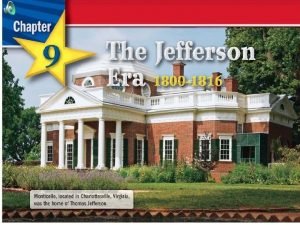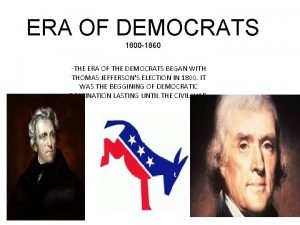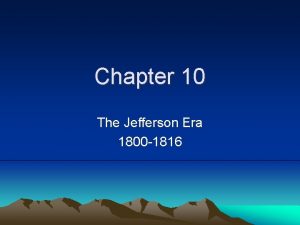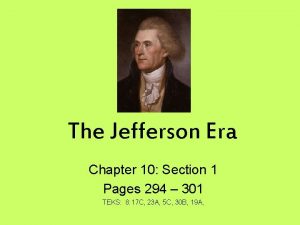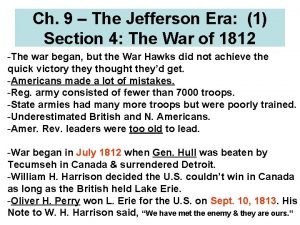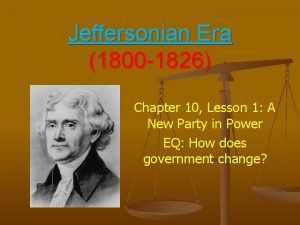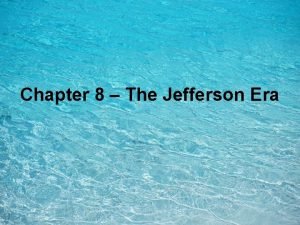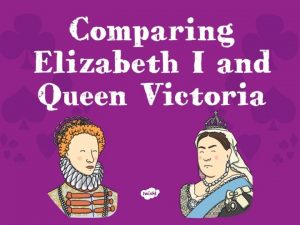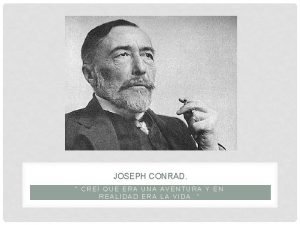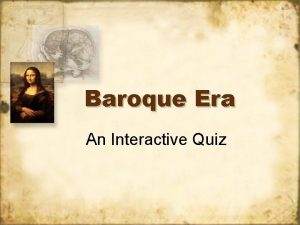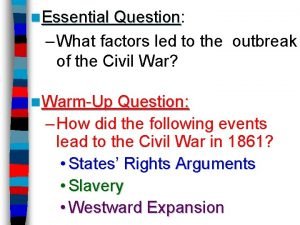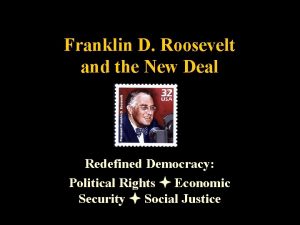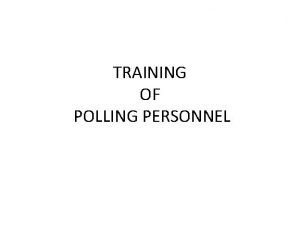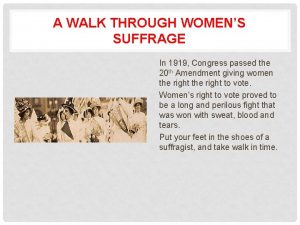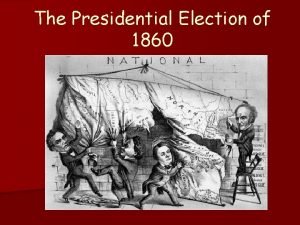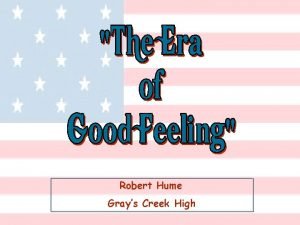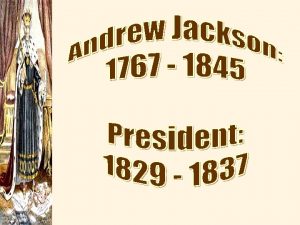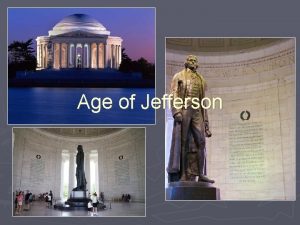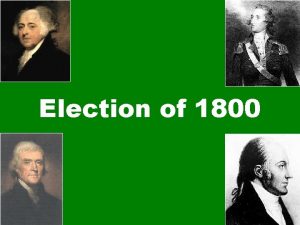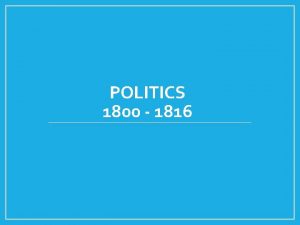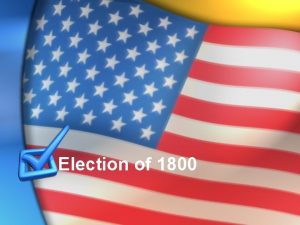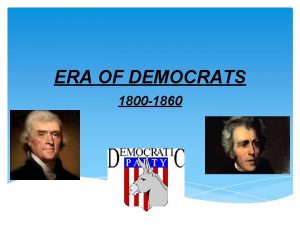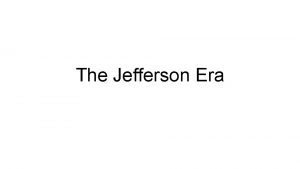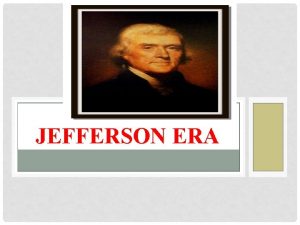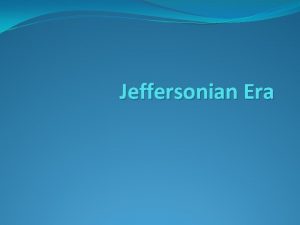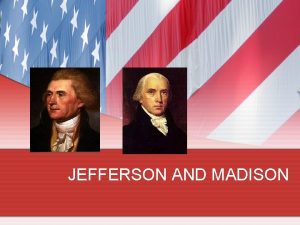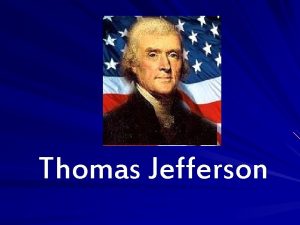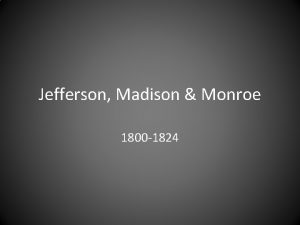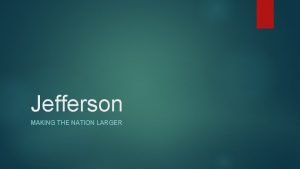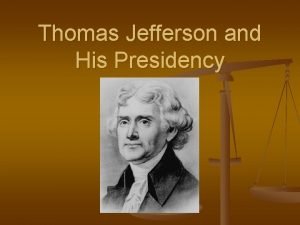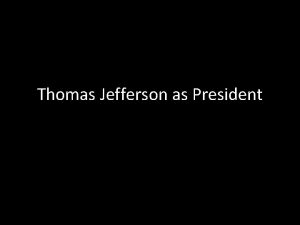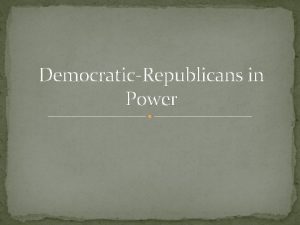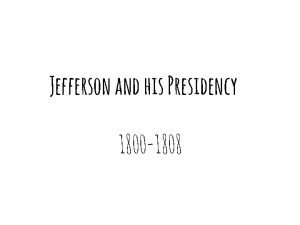The Jefferson Era Election of 1800 The death






















- Slides: 22

The Jefferson Era Election of 1800 The death of George Washington in December of 1799 would bring a temporary halt to the political fighting that had plagued the Adams Presidency. But the Election of 1800 would feature an all out battle for the Presidency between Democratic-Republicans who supported Vice-President Thomas Jefferson and Federalist who wanted to re-elect President John Adams Jefferson won the election! One Federalist newspaper said “the soil will be soaked with blood” if Jefferson was elected president

Only the Republican voters in the Electoral College made a mistake. Both Republican candidates tied with 73 votes. Adams received just 65 Aaron Burr 73 Thomas Jefferson 73

if such Number be a Majority of the whole Number of Electors appointed; and if there be more than one who have such Majority, and have an equal Number of Votes, then the House of Representatives shall immediately choose by Ballot one of them for President; the Votes shall be taken by States, the Representation from each State having one Vote and a Majority of all the States shall be necessary to a Choice. HOW DO SOLVE THISPROBLEM? House of Representatives had to vote to decide the winner. • - Federalists vote for Burr causing deadlock • - Hamilton, although he was against Jefferson, favored Jefferson over Aaron Burr. Hamilton thought Burr was dangerous and convinced Federalist to vote for Jefferson saying, “The public good must be (more important than) private (feelings) • Jefferson became the 3 rd President of the US, Burr would serve as V. P.

Thomas Jefferson as President • Policy – “We are all Federalists, we are all Republicans” • Keeps many Federalists in federal offices, appoints New Englanders to Cabinet positions – Economics: • Cancels Taxes on farms – makes western farmers happy • Maintains National Bank • Cuts spending to decrease debt – Cuts Navy spending down to a “Mosquito Fleet” – Increases revenue through western land sales

Jefferson’s Talents • He was a talented architect. He designed and built his home in Virginia Monticello. Also influenced design and architecture in Washington DC. • Wrote his own version of the Bible in which he took out all of the supernatural things and focused on its message. • His large book collection started the Library of Congress when he donated it.

John Marshall and the Supreme Court • Before John Adams left office, he appointed John Marshall as the Chief Justice of the Supreme Court. He would hold the position for the next 34 years. • He would shape the Supreme Court into the most powerful court in the nation and preside over 1, 000 court cases.

Marbury v. Madison • One of the most important early Supreme Court cases that Marshall decided was Marbury v. Madison • For the first time ever, the Supreme Court ruled a law passed by Congress and signed by John Adams was Unconstitutional. Meaning the law violated the Constitution. Part of Marshall’s ruling engraved into the Supreme Court Building This helped establish Judicial Review which means the courts do have the power to review laws and decide if they are Constitutional.

Louisiana Purchase • Napoleon Bonaparte was the military leader (later emperor) of France. • He forced Spain to sign the treaty of San Ildefonso in 1800 which returned Louisiana to France • In 1803 to raise money his war against England to fight a rebellion in Haiti, Napoleon sold the Louisiana territory to President Thomas Jefferson and the United states for $15 Million dollars.

The Louisiana Purchase doubled the size of the United States!

• http: //www. youtube. com/watch? v=s. Mh 8 RCq. Jf 9 U

Lewis and Clark • After purchasing the Louisiana territory Jefferson assigned Meriwether Lewis, a Captain in the U. S. Army, to explore the new American Territory. • Lewis and Jefferson planned the expedition together. • Lewis selected his friend William Clark to go with him and help lead the expedition which soon became known as the Lewis and Clark Expedition.

The Corps of Discovery • The Lewis and Clark expedition began in 1804. • Lewis and Clark assembled a team to travel with them which they called the “Corps of Discovery” • The purpose of the expedition was to explore the new territory. • This was the first expedition that crossed the United States all the way to the Pacific Ocean.


Captain Meriwether Lewis • Meriwether Lewis was born in 1774. • He joined the army at 20 years old. • He was made President Jefferson’s personal secretary in 1801. • Jefferson asked Lewis to lead and the Corps of Discovery. • Lewis was the scientist on the journey, keeping detailed records of the plants and animals they found.

William Clark • William Clark was born in 1770 and at 19 joined the military. • Clark met Meriwether Lewis when they were both in the army. • Lewis asked Clark to help him lead the expedition across the country. • Clark was the geographer on the trip, keeping a detailed diary including many drawings and maps.

• Sacagawea was a Native American woman and was only 12 when she was kidnapped and sold into slavery and about 16 when she “married” Charbonneau. • She would serve as interpreter on the journey. • Sacagawea had a son during the expedition. • Sacagawea’s image was made into a dollar coin in 1997. Sacagawea

Jean Baptiste Charbonneau • Jean Baptiste Charbonneau was the son of Toussaint Charbonneau and Sacagawea. • He became the youngest explorer on the Corps of Discovery. • Clark nicknamed him “Pomp. ”

• York was Clark’s childhood companion and his “manservant”, which meant he was a slave. We know he was big. We know he was very athletic and a great dancer. He was devoted to William Clark. He was a great help to the expedition because he was such a curiosity. • Indians had never seen a black man before. This painting depicts and actual event where a chief tried to rub the black off of York’s skin. • York was finally set free ten years after the expedition ended. York

The Corps of Discovery

Ocean in View! O’ the Joy! • It took the expedition a year and a half to go from St. Louis, Missouri to the mouth of the Columbia River in modern-day Washington State and another 10 months to return to St. Louis. • The total journey lasted just over two years! • They were the first Americans to cross the continent!

The Explorer Zebulon Pike was charged with finding the sources of the Arkansas and Red Rivers, and brought back valuable descriptions of the Great Plains and the Río Grande River Valley. He described the Great Plains as a desert, which led many Americans to believe that it was uninhabitable.

Impact of Western exploration from 1804 -1807 • Accurate maps • Growth of the fur trade • Belief that the U. S. should extend to the Pacific Ocean and a mistaken view of the Great Plains
 The election of 1800 showed that
The election of 1800 showed that Era of the democrats 1800-1860
Era of the democrats 1800-1860 The jefferson era worksheet answers
The jefferson era worksheet answers The jefferson era lesson 1 a new party in power
The jefferson era lesson 1 a new party in power Chapter 10 the jefferson era
Chapter 10 the jefferson era Chapter 10 the jefferson era
Chapter 10 the jefferson era The jefferson era section 4
The jefferson era section 4 Chapter 10 lesson 1 a new party in power
Chapter 10 lesson 1 a new party in power The jefferson era answer key
The jefferson era answer key Elizabethan and victorian era
Elizabethan and victorian era Creí que era una aventura y en realidad era la vida
Creí que era una aventura y en realidad era la vida Vi uma estrela tão alta
Vi uma estrela tão alta Baroque music quiz
Baroque music quiz Difference between somatic death and molecular death
Difference between somatic death and molecular death Abraham lincoln's election
Abraham lincoln's election Dcrc full form in election
Dcrc full form in election Tn dams
Tn dams How to write duty slip certificate
How to write duty slip certificate Election day political cartoon
Election day political cartoon Party platform definition
Party platform definition Election of 1824
Election of 1824 Was andrew jackson a president
Was andrew jackson a president 1960 election
1960 election
